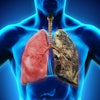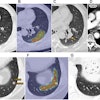Two of every three adults and some 25 million children in the U.S. are overweight, and chances are slim that the situation will get any better before it gets worse. Despite an explosion of diet books and weight-loss aids on the market, obesity rates rose in 31 states last year, according to a recent report by the Washington, DC-based health advocacy group Trust for America's Health.
Experts disagree about which measures of obesity most accurately predict the risk of atherosclerosis, which is itself significantly associated with morbidity and mortality. And the precise relationship between obesity and atherosclerosis is also unclear, as are the best methods of measuring them, the report notes. Is the body mass index (BMI), a common measure of obesity, also able to predict atherosclerotic disease?
Not very well, according to a new analysis of data from the Dallas Heart Study. The analysis found that only the waist-to-hip size ratio (WHR), not BMI or waist circumference (WC) alone, was independently associated with atherosclerosis at electron beam CT (EBCT) and cardiac MRI (CMR).
"Authors of previous studies evaluating the association between obesity and cardiovascular risk have reported varied results," wrote Drs. Raphael See, Shuaib Abdullah, Darren McGuire, and colleagues from the University of Texas Southwestern Medical Center in Dallas. "Population-based studies measuring clinical cardiovascular events have reported threshold effects, J-shaped relationships, and linear relationships. Angiographic studies have reported both direct and inverse relationships between increasing obesity and atherosclerotic burden" (Journal of the American College of Cardiology, August 21, 2007, Vol. 50:8, pp. 752-759).
Most of the earlier studies used BMI rather than alternative measurements such as WHR or WC as their primary measure of obesity, See and colleagues noted. The present study used the multiethnic population-based Dallas Heart Study to evaluate the association between these different measures of obesity and coronary artery calcium (by EBCT) and aortic plaque (by CMR) in prevalent subclinical atherosclerosis in 2,971 subjects who completed all three phases of the study between 2000 and 2002.
The third visit, at the end of the two-year trial, included imaging and a detailed clinical exam, including measurement of plasma lipids, glucose, and blood pressure (hypertension was defined as systolic blood pressure ≥ 140 mm Hg, diastolic blood pressure ≥ 90 mm Hg, or the use of hypertensive medications; elevated triglycerides were defined as > 200 mg/dL fasting). The subjects also underwent two EBCT measurements of coronary artery calcium and abdominal MRI.
EBCT data were acquired for Agatston calcium scoring in a single breath-hold using an Imatron C-150XP scanner (GE Healthcare, Chalfont St. Giles, U.K.), a field-of-view of 20 cm, 512 x 512 matrix, and 3-mm table increment.
Abdominal MRI was performed using a 1.5-tesla whole-body MRI scanner (Intera, Philips Medical Systems, Andover, MA) using a free-breathing, electrocardiogram-gated T2-weighted turbo spin-echo (black blood) sequence, the authors noted. After manual contouring of the areas of increased signal intensity, luminal protrusion and focal wall thickening, these findings were ascribed to aortic plaque.
"Subjects were divided into gender-specific quintiles based on BMI, WC, HC (hip circumference), and WHR, and female and male subjects within each gender-specific quintile were combined," the research team wrote.
Univariable logistic regression models were created to determine odds ratios for prevalent coronary artery calcium within each quintile, and multivariable logistic regression models were constructed to include traditional cardiovascular risk factors such as age, diabetes, smoking, hypertension, hypercholesterolemia, low HDL, and high triglycerides.
Univariate analysis in 2,744 subjects showed that coronary artery calcium prevalence was significantly greater only in the fifth versus the fourth quartile of BMI, whereas the prevalence increased stepwise across the quintiles of WC and WHR (p trend < 0.001 for each).
"After multivariate adjustment for standard risk factors, prevalent CAC (coronary artery calcium) was more frequent in the fifth versus the first quintile of WHR (odds ratio 1.91, 95% confidence interval 1.30 to 2.80), whereas no independent positive association was observed for BMI or WC," they wrote. "Similar results were observed for aortic plaque in both univariable and multivariable-adjusted analyses."
The c-statistic (analogous to the area under the ROC curve) for the discrimination of prevalent coronary artery calcium was greater for WHR compared with BMI in both women and men (p < 0.001 versus BMI; p < 0.01 versus WC).
In addition, prevalent coronary artery calcium in the sample was strongly associated with BMI, WC, and WHR in a univariate analysis of both men and women -- with the association strongest for WHR and weakest for BMI.
"After adjustment for traditional risk factors, only WHR was independently associated with CAC, an observation also found with aortic plaque," the group reported. "Of the measures of obesity, WHR showed superior discrimination for CAC and aortic plaque in unadjusted models but did not increase the c-statistic beyond traditional risk factors."
While obesity is well recognized as a risk factor for cardiovascular events, the mechanisms underlying that risk are not well established, the group noted. Still, adipose tissue itself has been shown to be proinflammatory, and alterations in cardiac structure and function as a result of obesity may lead to heart failure and arrhythmia.
Owing to the strong association between coronary artery calcium and atherosclerosis, and the typical long delay before adverse events occur, the study findings suggest that obesity itself may affect the initiation and progression of atherosclerotic disease, the researchers wrote, adding that the study findings are consistent with the relationship between BMI and mortality that has been reported previously. But the utility of BMI has been limited.
"These observations with regard to BMI have created uncertainty regarding the link between obesity and atherosclerosis, and highlight some of the inherent limitations of BMI to predict adverse health-related outcomes," they wrote. "In contrast, WC and WHR may more accurately reflect the additional risk conferred by obesity as demonstrated by the current findings."
"Waist-to-hip ratio showed better discrimination of atherosclerosis than either BMI or WC," See and colleagues concluded.
By Eric Barnes
AuntMinnie.com staff writer
September 11, 2007
Related Reading
Obesity associated with better outcomes after acute coronary syndrome, August 29, 20077
Larger waists linked to clogged arteries in teens, July 26, 2007
Obesity predicts prostate cancer recurrence after radiation therapy, August 21, 2007
Being overweight ups risk of colon cancer, July 6, 2007
Obesity forces radiology to supersize, enhance x-ray technology, March 1, 2007
Copyright © 2007 AuntMinnie.com




















